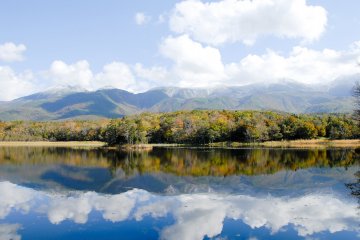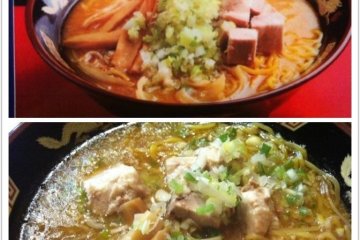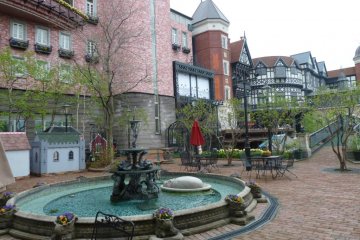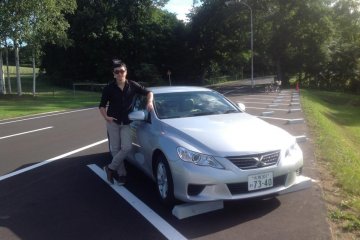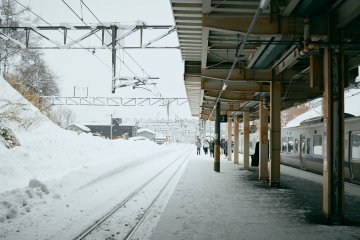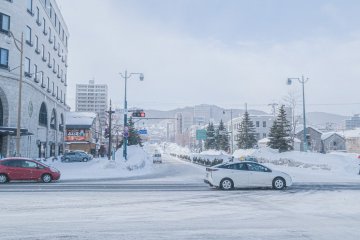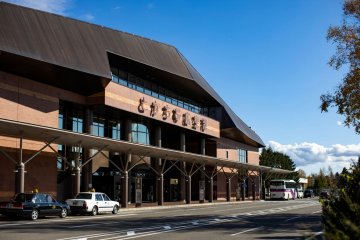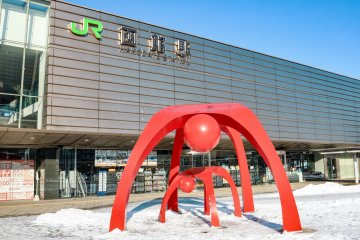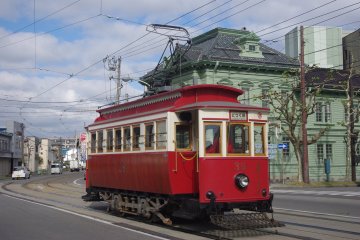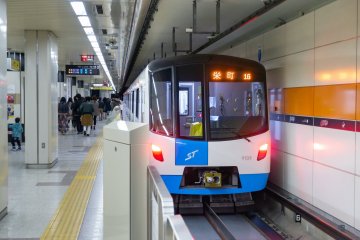Hokkaido is an exciting area, filled with memorable destinations and activities. The prefecture’s remarkable airports, railways, buses, rental cars, and subways ensure that you have the means to achieve your desired itinerary.
Our access guide will help you efficiently navigate the diverse landscape, giving you confidence in planning your next adventure!
Orientation
Where is Hokkaido?
Hokkaido is the northernmost of Japan’s four main islands and the country’s largest prefecture.
The island is overflowing with natural beauty, which is on full display in Akan, Shikotsu-Toya, and Shiretoko National Parks, making it a popular destination for nature enthusiasts. During winter, Hokkaido is a world-renowned spot for winter sports and festivals, enticing people globally with its pristine slopes. Niseko is especially famous for its ski resorts. The prefecture’s cities are equally thrilling and contain unique museums, parks, and fresh seafood restaurants. Popular urban getaways in Hokkaido include Hakodate, Otaru, and, of course, its capital city Sapporo.
Getting to Hokkaido
By Plane
The most common way to fly into Hokkaido is on a domestic flight from Haneda or Narita airport in Tokyo to the prefecture’s main airport, New Chitose in Sapporo. New Chitose airport is an international and domestic hub known for its efficient airway processes and entertaining shops and activities. The airport has an abundance of accessible buses and trains to Sapporo, with the JR train being especially popular as it only takes about 35 minutes to travel to Sapporo Station.
It is also relatively common for travellers to have connecting flights from South Korea or China. While direct flights into Hokkaido from countries outside of Asia are possible, they are not as commonplace. If you are looking to explore areas outside of Sapporo, the prefecture’s central Asahikawa and Obihiro, southern Hakodate, and eastern Kushiro and Memanbetsu airports are ideal choices.

By Train
While airway travel is the most time-efficient way to enter Hokkaido, you can also opt to visit the island by train via the Hokkaido Shinkansen Line. The underwater Seikan Tunnel connects Aomori prefecture to Hokkaido. Hayabusa trains, a category of Shinkansen bullet trains, travel from Tokyo Station to Shin-Hakodate-Hokuto Station near Hakodate, which is about a 4 hour ride. Please note that Hayabusa trains require seat reservations beforehand.
From Shin-Hakodate-Hokuto, you can take the Hakodate Liner to Hakodate Station, which is only about 20 minutes or transfer to the Ltd Express Super Hokuto train, which connects to Sapporo Station in about 3 hours and 30 minutes.

Getting Around Hokkaido
By Plane
If you are looking to optimize your time, a quick option to get around Hokkaido’s major cities is through its local airports. Hokkaido Air System, or HAC, has domestic flights throughout the region including connections to Asahikawa, Hakodate, Kushiro, and Sapporo, to name a few.
Learn more about Hokkaido's major airports.

By Train
One of the best ways to travel throughout Hokkaido is its railways. The prefecture’s trains are not only efficient but can also be integrated into your vacation by providing magnificent sightseeing opportunities. Below are the main cross-Hokkaido lines that connect the entirety of Hokkaido, many of which begin in Sapporo:
- Sapporo-Higashi-Muroran-Hakodate
- Sapporo-Asahikawa-Abashiri
- Sapporo-Asahikawa-Wakkanai
- Sapporo-Kushiro
- Sapporo-New Chitose Airport
- Sapporo-Otaru-Oshamambe
- Sapporo-Hokkaido-Iryodaigaku
- Asahikawa-Furano
- Kushiro-Abashiri
- Takikawa-Shintoku
JR Hokkaido offer useful route maps to help illustrate the different options available.
Most local trains, which stop at every station, only require a basic fare ticket with no need to reserve a seat. Though please note that you may be unable to find a seat during peak travel times.
The rapid or limited express trains, which stop at fewer stations than the local ones, offer a combination of reserved and non-reserved seating. In addition to a basic fare ticket, you must also purchase a ticket to reserve a seat. If you choose to ride the limited express train, you are required to purchase a limited express ticket as well.
Lastly, the shinkansen bullet train to Hakodate requires seat reservations and additional ticket purchases similar to the limited express trains. While the Hokkaido Shinkansen only covers two stations (Shin-Hakodate-Hokuto and Kikonai bound for Aomori), a high-speed route connecting to Sapporo is expected to open around 2030.
As mentioned above, JR Hokkaido also has multiple trains that are not only functional as means of transportation, but also provide memorable sightseeing excursions. These brightly colored trains travel through Hokkaido’s diverse landscape with views of the Kushiro wetlands, Shiretoko mountain range, the Sea of Okhotsk, Furano lavender fields, and much more!
- SL Fuyu-no-Shitsugen Train
- Ryuhyo Monogatari Train
- Kushiro Shitsugen Norokko Train
- Furano Biei Norokko Train
- Furano Lavender Express
- Lilac Asahiyama Zoo Train
- Express Niseko
Please note that the above trains may require reserved seating, be a combination of non-reserved and reserved seating, or be exclusively non-reserved seating. Be sure to check seat and ticket requirements ahead of time.

By Subway
If you are looking to explore Sapporo, the Sapporo Municipal Subway is a convenient way to travel around the city. The mostly underground subway consists of three lines, Namboku, Tokai, and Toho, which all meet at Odori station. The subways are also connected to the city’s railways and buses, providing easy transfers to both. You can purchase subway tickets at automatic ticket machines located at all stations. If you plan to use the subway multiple times in one day, it is a good idea to consider purchasing a One Day Ticket, which offers unlimited rides for a flat rate of ¥830 for adults and ¥420 for children (as of Fall 2020).

By Bus
Similar to Hokkaido’s trains, its buses provide reliable transportation to major cities in the region, as well as sightseeing opportunities. The prefecture’s intercity bus system is centered in Sapporo with wide-spread reaches to popular destinations such as Furano, Hakodate, Asahikawa, Otaru, and Shiretoko. Travel times vary greatly from 1 hour to nearby Otaru to over 7 hours to Shiretoko. Please note that some bus routes require reservations while others do not.
If you are planning on frequently utilizing the bus system during your stay, we recommend looking into the Hokkaido Inter City Bus Pass (ICBP) or Hokkaido Budget Bus Pass (HBBP). Details are listed in the Transport Passes section.
Hokkaido also offers a variety of sightseeing buses that travel in the prefecture’s popular destinations, such as Sapporo, Shiretoko Peninsula, Kushiro Marshland, Furano, Biei, Asahikawa, and much more.
Please note the time of year when planning your bus routes as buses become crowded during holidays.
By Rental Car

If you plan to explore Hokkaido’s countryside, where public transportation may be limited, or desire flexibility in your travels, then you should consider renting a car. In order to rent a car, you will need to obtain an International Driver’s Permit (IDP) before arriving in Japan. Most companies make renting vehicles easy via their websites. Prices for rentals usually range from ¥5,000 to ¥10,000 per 24-hour period, and vary depending on the car type. Make sure the rental car comes with a GPS with international language options.
If you plan on utilizing Hokkaido’s expressways, you should consider renting an ETC (Electronic Toll Collection) add-on or purchasing a Hokkaido Expressway Pass. These passes allow you to pass through tolls without stopping. The ETC keeps track of toll fees so you can pay the total amount when you return the vehicle, while the Hokkaido Expressway Pass offers you a fixed rate based on the number of days you travel.
Please note that winter driving in Hokkaido can be cumbersome as many of the areas become covered in snow and ice making the roads difficult to navigate. Although car rental companies in snowy areas provide snow tires by default, driving can still be intimidating for inexperienced winter drivers. Therefore, you should consider the time of year and the conditions of your desired destinations before committing to a rental car.
By tram

Sapporo and Hakodate are the only cities in Hokkaido that have tram, or streetcar, networks. These brightly colored, sometimes vintage and sometimes modern-looking trams are a fun and convenient way to get around the cities, and with their frequent running times you do not have to worry too much about planning ahead. Just hop on and enjoy the ride!
The tram network in Sapporo, called Sapporo Streetcar, travels in a loop in the center of the city and runs every 5-7 minutes. The streetcars operate from 6:00 to around 23:00 and provide easy transportation to 24 stops, as well as connections with the subways. The entire loop takes a little under an hour and is an excellent way to explore central Sapporo. A single ride on the tram costs ¥200 yen for adults and ¥100 for children. If you plan on utilizing the streetcar multiple times a day, consider purchasing the One-Day Streetcar Pass or Dosanko Pass. Details are listed in the Transport Passes section.
Hakodate’s tram network, Hakodate Shiden, has two routes with streetcars arriving every 6-12 minutes. The streetcars travel through the main parts of the city, providing convenient transportation to some of its popular sightseeing spots and Hakodate Station. Both routes, Route 2 and 5, are identical except for the last three stops. Route 2 heads south to Yashigashira, while Route 5 travels north to Hakodate Dock-mae. Tram fares range from ¥210 to ¥260 depending on the starting and ending points of the ride. If you plan on riding the tram multiple times in one day, consider purchasing a One-Day Tram Pass. Details are listed in the Transport Passes section.
Please note that the Sapporo and Hakodate streetcars become crowded during peak travel times.
Hokkaido Transit Passes
Below are a number of economically priced passes that can help streamline your travels by eliminating the hassle of purchasing multiple tickets at various spots. Please note that the pricing below is up-to-date as of Fall 2020.
Airways
- JAL Japan Explorer Pass: This pass offers a fixed fee for domestic airway travel to over 30 cities in Japan. Fare prices range from ¥5,500 to ¥11,000. More
Trains
- JR Hokkaido Rail Pass: This pass allows holders to ride all JR Hokkaido trains, except Hokkaido Shinkansen, and some JR buses. You can purchase 3, 4, 5, or 7 day plans, which cost ¥17,400/¥8,700, ¥23,480/¥11,740, ¥23,480/¥11,740, and ¥25,710/¥12,850 respectively for adults/children. More
- JR East-South Hokkaido Rail Pass: This pass offers unlimited train rides on valid routes in East Japan and Hokkaido for 6 days. For adults/children, prices range from ¥26,900/¥13,450 to ¥27,930/¥13,960. Note that the pass’s price is less expensive if you purchase it outside of Japan. More
- JR Tohoku-South Hokkaido Rail Pass: This pass offers unlimited train rides on valid routes in Tohoku and Hokkaido for 5 days. For adults/children, prices range from ¥19,750/¥9,870 to ¥20,790/¥10,390. Note that the pass’s price is less expensive if you purchase it outside of Japan. More
- Japan Rail Pass: This pass allows holders to travel throughout Japan via eligible trains, buses, and ferries with Green Car and Standard Car options. You can purchase 7, 14, and 21 day passes, which range in price from about ¥40,000/¥20,000 to ¥90,000/¥45,000 for adults/children.
Buses
- Hokkaido Inter City Bus Pass (ICBP): The ICBP allows users to take any bus in central Hokkaido without reservations. For adults/children, the pass costs ¥6,000¥/3,000 (3 days) or ¥9,000/¥4,500 (5 days). More
- Hokkaido Budget Bus Pass (HBBP): The HBBP works similar to the ICBP (above), except that it includes long-distance bus routes as well. Adult/child pricing for HBBP is ¥11,000/¥5,500 (3 days) or ¥17,000/¥8,500 (5 days). More
Trams
- One-Day Streetcar Pass: This pass offers users unlimited rides on the Sapporo Streetcar for one day at a fixed rate. The pass costs ¥500 for adults and ¥250 for children. More
- Dosanko Pass: This pass offers one adult and one child unlimited rides on the Sapporo Streetcar for one day on weekends and holidays. The pass costs ¥370. More
- One-Day Tram Pass: This pass offers users unlimited rides on the Hakodate Tram for one day. The pass costs ¥600 for adults and ¥300 for children. More



